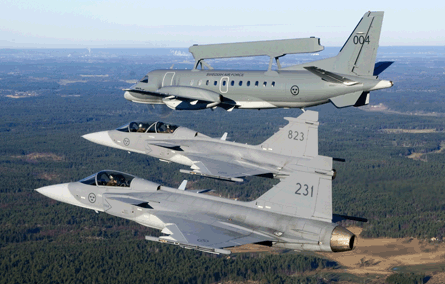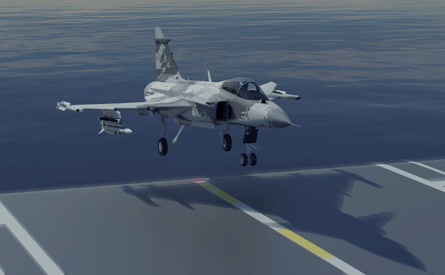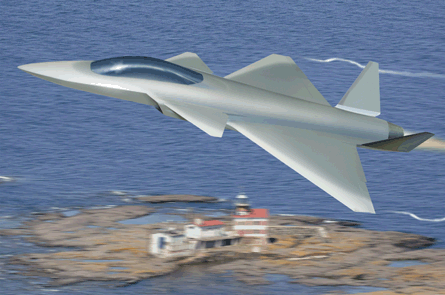A lot has happened since Saab rolled out its Gripen NG demonstrator in April 2008. Although the Swedish manufacturer has not secured a new order for its fighter product since this time, flight-testing is proceeding well, and it has also added another member to the family in the Sea Gripen concept.
NEW WEAPONS
The first phase of Gripen NG flight-testing started in May 2008 and totalled 79 sorties. A maximum speed of over Mach 1.6 was demonstrated, along with "supercruise" capability at more than M1.2, says Hans Rosén, head of Gripen marketing and campaigns.
An altitude of 36,000ft (11,000m) was also demonstrated, along with a +9/-3g load factor and maximum angle of attack, while some medium and heavy external stores were also carried.
 |
|---|
© Katsuhiko Tokunaga/Gripen International |
"All goals were achieved," according to Rosén, who adds that a "very good comparison to models was observed, and acceleration noticeably improved."
A second test phase started in late October 2009 and is ongoing. By 12 June, when Saab representatives briefed journalists at the company's Linköping manufacturing site, 73 flights had already been performed.
Achievements so far have included testing the NG's new missile approach warning system (MAWS) and active electronically scanned array radar (AESA), with work on its satellite communications fit yet to be completed. The aircraft's ability to carry an increased internal fuel load has also been shown.
Installed on the bottom surface of the wing root area, in front of the main landing gear bay and on the tailcone sides, the MAWS has automatically dispensed flares in testing in response to a simulated missile threat using a ground-based UV-illuminator.
Flights carrying Raytheon GBU-49 Paveway 226kg (500lb) precision-guided bombs, plus Diehl BGT Defence IRIS-T short-range air-to-air missiles and MBDA Meteor beyond-visual-range air-to-air missiles are in progress.
A new underwing 1,700 litres (450USgal) fuel tank has also been flown, and supersonic drop-tanks will also be tested in the future.
The Gripen NG will have a maximum take-off weight of 16.5t: around 2.5t heavier than the current production-standard aircraft. Its maximum payload will be 7.2t and maximum fuel 7.1t.
 |
|---|
© Frans Dely/Gripen International |
It will have a ferry range of more than 2,200nm (4,070km) using internal and externally carried fuel only, and an unrefuelled combat radius of 700nm, with supercruise possible above M1.2.
NETCENTRIC CAPABILITIES
The heart of the Gripen NG is its ES05 Raven second-generation AESA radar, developed by Selex Galileo and Saab. Capable of working in air-to-air, air-to-ground and electronic countermeasures modes, the system will use a "swashplate" mounting, enabling its angled antenna to be rotated to provide a larger angle of coverage than a fixed array. Crucially, the companies say this would enable a fighter to continue tracking its target while manoeuvring after launching a missile.
"AESA radar is heavier than mechanical, but the swashplate is not very massive," says Eddy de la Motte, technical director of Gripen and campaign director for its sales campaign in India.
The NG also varies from older models by using an open architecture avionics system, which separates flight critical and mission critical functions and allows for the future addition of off-the-shelf elements. It also has an improved databus structure and a new fighter datalink to support net-centric operations with air, land, sea and space assets. This will also be interfaced with Link 16, satellite communications and digital close air support link.
Two-seat examples could be used to manage sensor sharing with other aircraft, or for electronic-attack, air battle management or to lead unmanned combat air vehicles.
Data gathered by the aircraft's radar, infrared search and track sensor, weapons, sensor pods and electronic warfare equipment will be fused, along with information from other platforms.
Survivability will also be increased, with a missile approach laser warning system, towed decoys, enhanced electronic support measures and chemical, biological, radiological and nuclear protection.
And in the cockpit, the crew will use a modern interface, with large touchscreen displays, direct voice input and 3D audio.
EXPORT PROSPECTS
According to Saab's analysis, a market exists for the production of around 2,500 new fighters by 2025, excluding requirements in China, Russia and the USA. Double this number will be retired, it says.
"Air forces will downsize their combat aircraft fleets, but the market is still huge," says Rosén. "After years of economic crisis some tenders will be relaunched, so that will be a lot of work for manufacturers."
Looking out to 2016, Saab-led Gripen International sees multiple export opportunities for almost 230 aircraft with Bulgaria (16), Croatia (12), the Czech Republic (10), Denmark (36), Hungary (six), Malaysia (12), the Netherlands (85), Romania (24), Switzerland (22) and Thailand (six).
 |
|---|
© Gripen International |
"The main advantage of Gripen is low operating cost in comparison with larger aircraft equipped with two engines," says de la Motte. "Now for the Flygvapnet [Swedish air force] the cost per flight hour is less than $3,000 and for the export customers it will be less than $5,000, including maintenance, spare parts, fuel and manpower."
Nearer term, there are two other tenders where not only the Gripen NG will be offered, but the proposed Sea Gripen could also be developed.
The Indian air force's medium multi-role combat aircraft deal seeks 126 fighters, including 108 to be built locally by Hindustan Aeronautics. Saab faces competition from the Boeing F/A-18E/F Super Hornet, Dassault Rafale, Eurofighter Typhoon, Lockheed Martin and F-16 and RSK MiG-35 for the massive prize.
Earlier this year an in-country evaluation of the Gripen NG was successfully completed, with the deployment representing the demonstrator aircraft's first international commitment.
The aircraft left Linköping on 17 May and the following day completed its ferry flight to Jamnagar via refuelling stops in Kecskemet (Hungary), Athens (Greece), Hurgada (Egypt), Riyadh (Saudi Arabia) and Muscat (Oman).
Trials were made in the harsh environmental conditions at Leh air base, 10,800ft above sea level in the Himalayas. During the day, the temperature was as high as 49°C (120°F).
"The aircraft was loaded with full fuel tanks and IRIS-T missiles. Eight sorties were made in India, both by Swedish and Indian air force pilots," de la Motte says.
The evaluations included in-flight refuelling with an Ilyushin Il-78MKI tanker, and engine ground runs and restarts were also performed, with to problems were reported. The Gripen NG returned to Sweden on 22-23 May.
Another big deal could be done with Brazil, where its F-X2 competition for 36 aircraft could in time rise to over 100. "We expect the winner will be announced during the next few weeks," Rosén says. Saab faces competition from the Rafale and Super Hornet, with Brazilian president Luiz Inacio Lula da Silva having previously openly backed the Dassault product.
SEA GRIPEN PARTNERS
The Sea Gripen will not be developed by Sweden alone, due to its lack of an aircraft carrier, but potential partners could include Brazil and India, who have been offered to do work in their own countries.
De la Motte says the "cost of that programme will be a couple of billion Swedish crowns; more than one billion. It will be half of the Gripen NG's development programme cost."
With the current Gripen's assisted anti-lock braking system enabling it to stop in 600m without an arrester hook or brake chute, de la Motte says: "Sea Gripen will be perfectly tailored to carrier operations." But for embarked use an emergency tail hook would be installed, along with a strengthened airframe and improved landing gear installation. It would also receive enhanced anti-corrosion protection for a life at sea.
 |
|---|
© Gripen International |
The current model also meets a low carrier approach speed of less than 150kt (277km/h), today achieving between 125kt and 160kt. However, it lacks the required sink rate of 25ft/s (7.62m/s), with 15ft/s now possible.
Sea Gripen would be able to perform catapult-assisted take-off but arrested recovery and short take-off but arrested recovery operations. This would make it suitable for classic aircraft carriers, such as Brazil's São Paulo, and ski-jump-equipped ships such as India's Vikrant-class.
Sweden is committed to using the Gripen system until 2040, with an upgrade philosophy to evolve its capability over a two- to three-year cycle.
To be designated the Gripen E/F in national service, the NG will be ready in 2015. The main question for Stockholm and Saab's other potential customers is how many will be acquired, and when.
Sweden has already decided that its E/F-model fighters - which will be upgraded from its current C/D-standard Gripens - should enter service in 2017-18. But if Saab wins one or more of its forthcoming sales opportunities, deliveries to the Swedish air force could be accelerated.
SWEDEN TO ADVANCE GENERIC FUTURE FIGHTER CONCEPT
Sweden's decades-long history of innovation in the aerospace sector is also evidenced by its Generic Future Fighter (GFF) concept.
Developed by the Fluid and Mechatronic Systems division at Linköping University's department of Management and Engineering, the design has a Gripen-like fuselage with canards and canted tails.
Saab and the Swedish Defence Materiel Administration (FMV) awarded the university a contract to build a 13%-scale demonstrator of the concept. With a 15kg (33lb) take-off weight, the design is 2.4m (7.8ft) long, has a wing span of 1.5m and is powered by a jet engine delivering a thrust of 35.9lb (160N).
 |
|---|
© ART |
The GFF was flown for the first time last November, and "performed as expected".
The goal of the demonstration effort has been to deliver a cost-effective platform to support Sweden's long-term aeronautics research and development strategy, and to serve as a "flying windtunnel". The GFF also incorporates features such as internal weapons bays, supercruise performance and stealth capability.
The latter will be delivered partly by using a double curved geometry radome, manufactured from composite material to reduce the aircraft's radar cross-section. Acab, the design's manufacturer, says the technology could also equip future versions of the Gripen, plus unmanned air vehicles.
Now equipped with flight-test instrumentation, Sweden's subscale fighter demonstrator is due to start a new campaign of flight-testing this summer.
Source: Flight International























